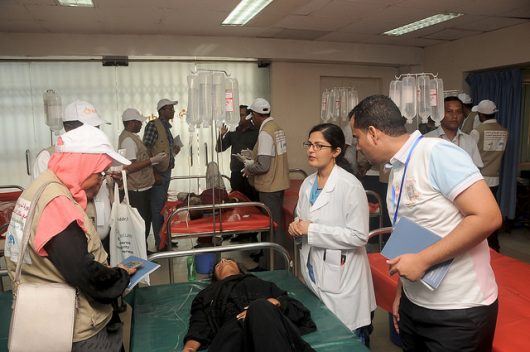The Cholera Crisis of 2018
 Cholera is a disease that is both preventable and treatable, though it can be fatal under the worst of circumstances. It typically affects the most destitute areas of the globe where sanitation practices are weakest. Random outbreaks can and do occur across all continents, however. The greatest challenge to diminishing the effects of a cholera crisis is that it can spread quickly among populations with a lack of adequate hygiene measures, proper vaccination or isolated and contained care centers.
Cholera is a disease that is both preventable and treatable, though it can be fatal under the worst of circumstances. It typically affects the most destitute areas of the globe where sanitation practices are weakest. Random outbreaks can and do occur across all continents, however. The greatest challenge to diminishing the effects of a cholera crisis is that it can spread quickly among populations with a lack of adequate hygiene measures, proper vaccination or isolated and contained care centers.
Disease Basics
According to the Center for Disease Control (CDC), cholera is caused by toxigenic Vibrio Cholerae, which leads to the acute bacterial intestinal infection. Symptoms include vomiting, diarrhea and, in severe cases, collapse and shock. Fatalities occur in approximately 25 to 50 percent of all cases. While cholera is uncommon in the U.S. and other developed nations, cases have been increasing around the world since 2005. The CDC classifies the magnitude of cholera outbreaks as a pandemic that has persisted for over four decades in Asia, Africa and Latin America.
Saltwater is the natural source where Vibrio Cholerae originates and may be passed on to humans by ingesting anything from infected water, like shellfish, crab and shrimp. The risk is heightened when any of these foods are undercooked or consumed raw. Cholera can be passed through the drinking water supply as well, which is a common form of transmission.
The Cholera Crisis
A cholera crisis occurred in February 2018 in Uganda, resulting in 700 reported cases and 27 deaths. In Malawi, an outbreak in April affected 893 individuals and caused 30 deaths. A recent outbreak has occurred in Yemen as well. The total number of cholera cases in Yemen over the past year is estimated to be 1,090,280 with 2,275 deaths. This means one out of every five people infected with cholera died last year in Yemen. In addition, Haiti has reported 432 cases of cholera this past year, with four deaths resulting from the disease.
Progressive Efforts
While contemplating the statistics shared in regard to the cholera crisis, it is important to think about what solutions are available to prevent this destructive disease from spreading and to know what actions are being taken to assist those who are suffering. The most obvious solution to a cholera crisis is to offer aid in the form of clean water solutions so potable water can be readily available to all.
The U.N. has made remarkable progress in its efforts to make clean water available to everyone around the world. More specifically, its efforts are known as the Water for Life International Decade for Action and took place during 2005-2015. As a result of this initiative, 1.3 billion people were provided with clean drinking water. It is estimated that there are still 2.5 billion people who drink contaminated water.
Improved sanitation practices and adequate facilities is also a dire need. The U.N. reports that there are currently 2.3 billion people worldwide who are without access to basic sanitation facilities, such as toilets. The two concurrent issues of lack of sanitation facilities and a lack of clean water interplay to cause illness amongst many in the form of communicable diseases passed through to the residents of poverty-stricken areas. As a result, approximately 1.5 million children die from related illnesses.
Efforts to help can generate a return on investment for those in developed nations. Research has shown that every U.S. dollar spent on improved sanitation generates a return of $9. World Water Day on March 22 and World Toilet Day on Nov. 19 are international observance days set aside to raise awareness of these issues.
– Bridget Rice
Photo: Flickr
